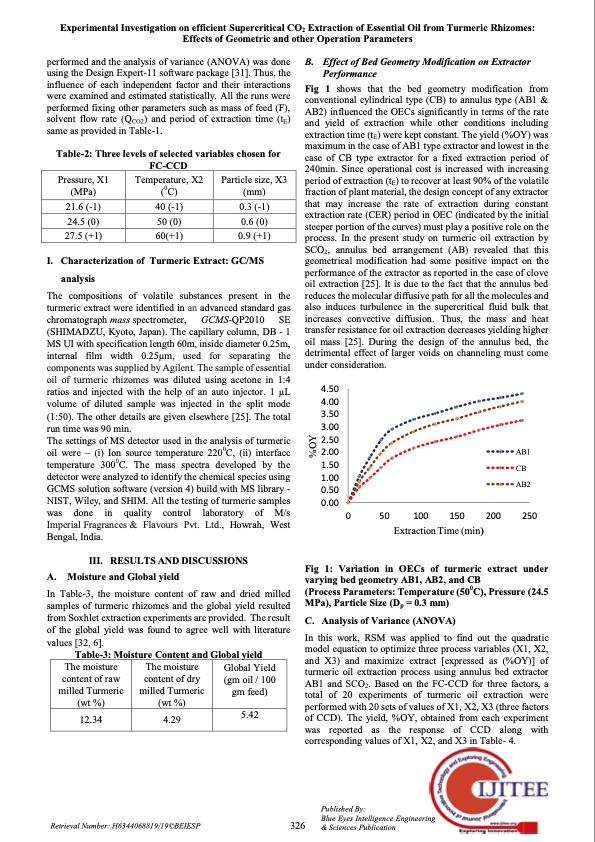
PDF Publication Title:
Text from PDF Page: 004
Experimental Investigation on efficient Supercritical CO2 Extraction of Essential Oil from Turmeric Rhizomes: Effects of Geometric and other Operation Parameters performed and the analysis of variance (ANOVA) was done using the Design Expert-11 software package [31]. Thus, the influence of each independent factor and their interactions were examined and estimated statistically. All the runs were performed fixing other parameters such as mass of feed (F), solvent flow rate (QCO2) and period of extraction time (tE) same as provided in Table-1. Table-2: Three levels of selected variables chosen for FC-CCD B. Effect of Bed Geometry Modification on Extractor Performance Fig 1 shows that the bed geometry modification from conventional cylindrical type (CB) to annulus type (AB1 & AB2) influenced the OECs significantly in terms of the rate and yield of extraction while other conditions including extraction time (tE) were kept constant. The yield (%OY) was maximum in the case of AB1 type extractor and lowest in the case of CB type extractor for a fixed extraction period of 240min. Since operational cost is increased with increasing period of extraction (tE) to recover at least 90% of the volatile fraction of plant material, the design concept of any extractor that may increase the rate of extraction during constant extraction rate (CER) period in OEC (indicated by the initial steeper portion of the curves) must play a positive role on the process. In the present study on turmeric oil extraction by SCO2, annulus bed arrangement (AB) revealed that this geometrical modification had some positive impact on the performance of the extractor as reported in the case of clove oil extraction [25]. It is due to the fact that the annulus bed reduces the molecular diffusive path for all the molecules and also induces turbulence in the supercritical fluid bulk that increases convective diffusion. Thus, the mass and heat transfer resistance for oil extraction decreases yielding higher oil mass [25]. During the design of the annulus bed, the detrimental effect of larger voids on channeling must come under consideration. 4.50 4.00 3.50 3.00 2.50 2.00 AB1 1.50 Pressure, X1 (MPa) 21.6 (-1) 24.5 (0) 27.5 (+1) Temperature, X2 (0C) 40 (-1) 50 (0) 60(+1) Particle size, X3 (mm) 0.3 (-1) 0.6 (0) 0.9 (+1) I. Characterization of Turmeric Extract: GC/MS analysis The compositions of volatile substances present in the turmeric extract were identified in (SHIMADZU capillary column, DB - 1 MS UI with specification length 60m, inside diameter 0.25m, internal film width 0.25μm, used for separating the components was supplied by Agilent. The sample of essential oil of turmeric rhizomes was diluted using acetone in 1:4 ratios and injected with the help of an auto injector. 1 μL volume of diluted sample was injected in the split mode (1:50). The other details are given elsewhere [25]. The total run time was 90 min. The settings of MS detector used in the analysis of turmeric oil were – (i) Ion source temperature 2200C, (ii) interface temperature 3000C. The mass spectra developed by the detector were analyzed to identify the chemical species using GCMS solution software (version 4) build with MS library - NIST, Wiley, and SHIM. All the testing of turmeric samples was done in quality control laboratory of M/s Imperial Fragrances & Flavours Pvt. Ltd., Howrah, West Bengal, India. III. RESULTS AND DISCUSSIONS A. Moisture and Global yield In Table-3, the moisture content of raw and dried milled samples of turmeric rhizomes and the global yield resulted from Soxhlet extraction experiments are provided. The result of the global yield was found to agree well with literature values [32, 6]. Table-3: Moisture Content and Global yield 1.00 0.50 0.00 CB AB2 0 50 100 150 200 250 Extraction Time (min) chromatograph mass spectrometer, GCMS-QP2010 SE an advanced standard gas , Kyoto, Japan). The The moisture content of raw milled Turmeric (wt %) The moisture content of dry milled Turmeric (wt %) Global Yield (gm oil / 100 gm feed) 12.34 4.29 Retrieval Number: H6344068819/19©BEIESP 5.42 Fig 1: Variation in OECs of turmeric extract under varying bed geometry AB1, AB2, and CB (Process Parameters: Temperature (500C), Pressure (24.5 MPa), Particle Size (Dp = 0.3 mm) C. Analysis of Variance (ANOVA) In this work, RSM was applied to find out the quadratic model equation to optimize three process variables (X1, X2, and X3) and maximize extract [expressed as (%OY)] of turmeric oil extraction process using annulus bed extractor AB1 and SCO2. Based on the FC-CCD for three factors, a total of 20 experiments of turmeric oil extraction were performed with 20 sets of values of X1, X2, X3 (three factors of CCD). The yield, %OY, obtained from each experiment was reported as the response of CCD along with corresponding values of X1, X2, and X3 in Table- 4. 326 Published By: Blue Eyes Intelligence Engineering & Sciences Publication %OYPDF Image | Supercritical CO2 Extraction of Essential Oil from Turmeric

PDF Search Title:
Supercritical CO2 Extraction of Essential Oil from TurmericOriginal File Name Searched:
H6344068819.pdfDIY PDF Search: Google It | Yahoo | Bing
CO2 Organic Rankine Cycle Experimenter Platform The supercritical CO2 phase change system is both a heat pump and organic rankine cycle which can be used for those purposes and as a supercritical extractor for advanced subcritical and supercritical extraction technology. Uses include producing nanoparticles, precious metal CO2 extraction, lithium battery recycling, and other applications... More Info
Heat Pumps CO2 ORC Heat Pump System Platform More Info
| CONTACT TEL: 608-238-6001 Email: greg@infinityturbine.com | RSS | AMP |